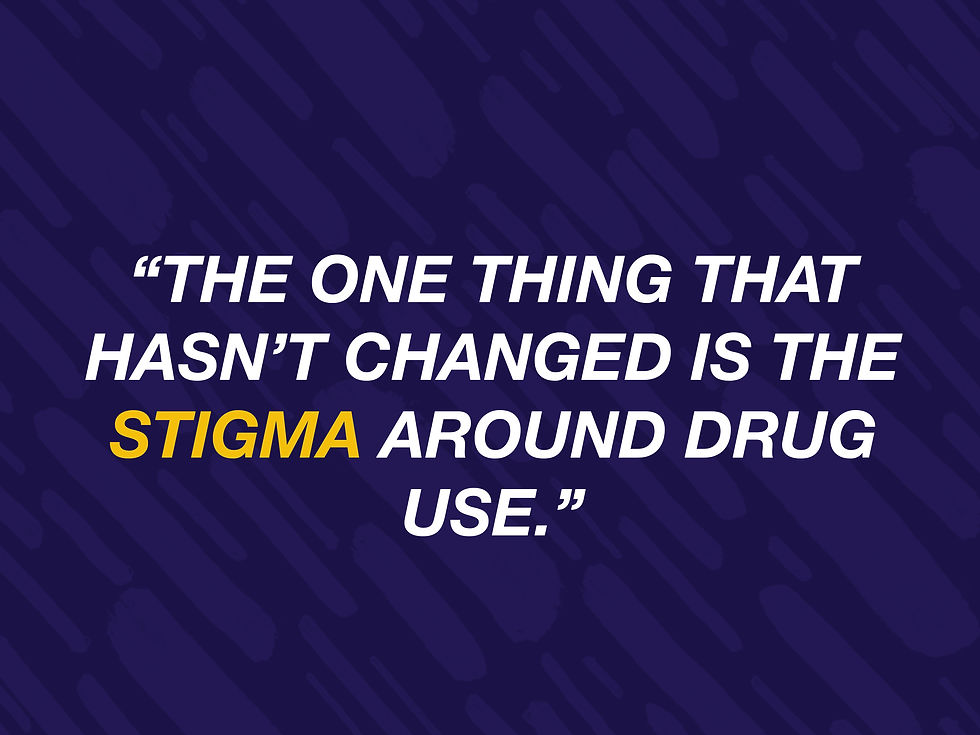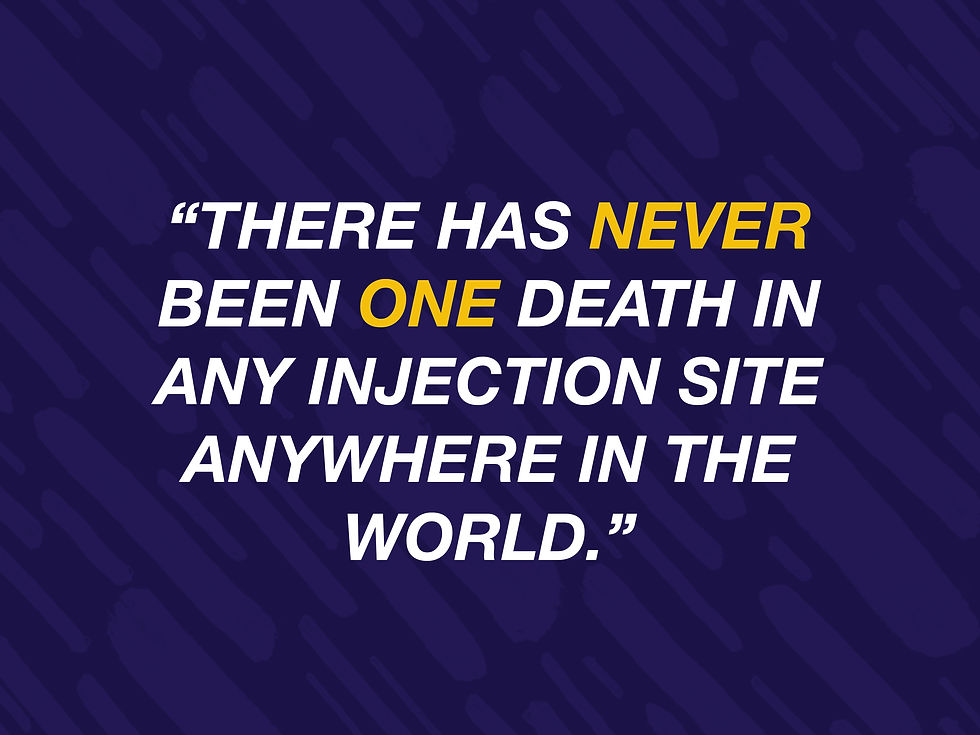The Overdose Crisis: A Way Forward
- twentytwentyarts

- Aug 16, 2020
- 5 min read
Updated: Aug 16, 2022
Nearly four-thousand Canadians lost their lives to an overdose in 2019. For the past twenty years in Ontario, the number of overdose deaths has increased year over year, and yet, many of those deaths are preventable. Misconceptions surrounding what addiction is, what ‘types’ of people use drugs, and what needs to change has largely informed the public response to the overdose crisis. In honour of this month’s International Overdose Awareness Day (August 31st, 2020), and our digital fundraising campaign for Toronto Street Health's OPS, we talked to Nick Boyce of the Ontario Harm Reduction Network to clarify some of those misconceptions.
STIGMA

Nick Boyce has been working in harm reduction for over twenty years. “The one thing that hasn’t changed is the stigma around drug use,” he explained. “I think that is in large part driven by the laws we have in criminalizing drugs and prohibiting certain drugs but not other ones—like alcohol or cannabis.” Drug prohibition in Canada is over one-hundred years old, and as Nick explained, laws were based on social issues at the time rather than on any kind of science or reasoning. Instead, these laws were written to target certain groups of people who were using drugs rather than the drugs themselves.
Addiction is far more common than you might think. People can become dependent on caffeine, nicotine, alcohol, and other drugs, and yet the stigma associated with them are vastly different. Those struggling with alcohol dependency do not face persecution in both legal and social realms in the same way people who use illegal drugs do. This has caused people who use drugs to become very isolated, which is incredibly dangerous.
OVERDOSE PREVENTION SITES

Since the beginning of the COVID-19 pandemic, the number of overdose deaths has increased by twenty-five percent. On the one hand, people are being told to socially distance to prevent the spread of COVID-19. On the other hand, people who use drugs are being told to use drugs in the presence of others in the event of an overdose. That’s where overdose prevention sites often come in. They are safe havens for people who use drugs, where they will not be charged for possession and can safely use under supervision. “There has never been one death in any injection site anywhere in the world,” said Nick. He believes this is the case partially because they are operating in a decriminalized environment where stigma is lessened and users can interact with people without fear. These sites also connect people with healthcare and mental health services among many others.
The closure of these centres, even with reduced hours or reduced capacity, is a serious problem. On a good day, many overdose prevention sites are working at capacity, according to Nick. With COVID-19, access to resources has been significantly diminished, particularly for those already lacking basic life necessities like housing. In Toronto, a group of homeless people, including those who use drugs, set up tents in Moss Park where they could live in the safety of a community during COVID-19. Recently, the city removed the group, displacing people perhaps in the most need of community support with little planning on how to replace this support. These are the kinds of issues drug users, among other disadvantaged populations, face on an ongoing basis. And most of it is rooted in stigma rather than science.
The problem is that governments and society are slow to change. They require immense pressure from citizens in order to take action, and even then, opinions on the best way to move forward are often divided. Take for example the Black Lives Matter movement in North America. The issues are not new, but they have reached a tipping point. Similarly, awareness of overdose death is becoming more common knowledge because of the recent spike in deaths. For Nick, ongoing awareness and education is needed to shift public and government thinking.

Studies show that overdose prevention sites work to reduce the number of deaths related to overdose, however, stigma only worsens the problem. When asked about the evidence, Nick pointed to Portugal where simple drug possession has been decriminalized. “So, it’s no longer considered a criminal issue,” he said, referencing the country’s action against the negative stigma surrounding drug use. “They’re treating it much more as a health and social issue.” As a result, Portugal now boasts low rates of HIV and Hepatitis-C transmissions as well as very few deaths related to drug overdose as a result of shifting resources. “The architect of that plan talks about how it’s reduced the stigma because you’re not afraid to come and talk about your drug use anymore because you’re not going to be punished for it,” said Nick. In the same sentiment, if someone who is using drugs in the presence of a friend overdoses, you don't want the fear of punishment to deter them from calling for help.
CONCLUSION
In sum, the best way to tackle the rising number of overdose-related deaths in Ontario, and more broadly in Canada, is to shift the status quo. Resources need to be reallocated to prevention rather than policing and punishment. Nick explained:
“I often hear people say—or you’ll see comments online saying—‘Why do we need to spend money helping these druggies? Why should we spend money helping “addicts”?’ And when people say that, I don’t think they realize how much money they are already spending on these issues.”
The fact is, far more money is spent on the policing and punishment of drug use than on prevention, and it has not stopped it yet. Clearly, it isn’t working. As demonstrated by other countries like Portugal, there is a better way. If you speak to anyone working in harm reduction, healthcare, or on the front lines of the overdose crisis, many of them feel the same way. Drug use is not a moral issue but a health issue, and decriminalizing drugs will help users get the help they need.

Drug prohibition causes more problems than it creates. Nick explained, “When you prohibit certain drugs, but the demand for them is still there, suppliers will find a way to produce them. When you prohibit how to make them and restrict the chemicals needed, suppliers will find alternatives and it actually incentivizes the production of different, often more potent drugs.” The unpredictability and toxicity of drugs created by suppliers to fill demand is increasing and is incredibly dangerous. Therefore, decriminalizing drugs and setting up an infrastructure to support the supply of quality drugs, such as what we do with cannabis now, could actually prevent serious complications, even death, and mitigate many other problems. Of course, change is not free, so the issue comes full circle. There has to be enough understanding of the issue and pressure on governments in order to create that change. But, in the end, it would cost less than policing and punishment and, most importantly, save lives.

Nick Boyce is a harm reduction advocate with over 20 years of experience in the field. He received his Bachelor of Science in neuropsychology from Dalhousie University and has been involved in numerous community and policy programs since. Some projects he has worked with include TRIP (Toronto Rave Info Project), the AIDS Committee of Toronto, the Ontario Ministry of Health’s Opioid Emergency Task Force, Addictions and Mental Health Ontario, and more. For the past two years, Nick Boyce has served as the Director of the Ontario Harm Reduction Network.





Comments